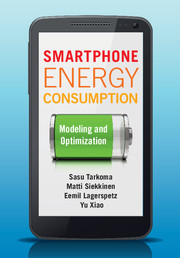Book contents
- Frontmatter
- Contents
- Preface
- List of abbreviations
- Part I Understanding energy consumption
- Part II Energy management and conservation
- Part III Advanced energy optimization
- 11 Overview
- 12 Traffic scheduling
- 13 Exploiting multiple wireless network interfaces
- 14 Mobile cloud offloading
- 15 Example scenarios for energy optimization
- 16 Future trends
- Appendix A An energy profile application
- Index
- References
13 - Exploiting multiple wireless network interfaces
from Part III - Advanced energy optimization
Published online by Cambridge University Press: 05 August 2014
- Frontmatter
- Contents
- Preface
- List of abbreviations
- Part I Understanding energy consumption
- Part II Energy management and conservation
- Part III Advanced energy optimization
- 11 Overview
- 12 Traffic scheduling
- 13 Exploiting multiple wireless network interfaces
- 14 Mobile cloud offloading
- 15 Example scenarios for energy optimization
- 16 Future trends
- Appendix A An energy profile application
- Index
- References
Summary
In this chapter, we continue to look at the different ways to reduce the energy consumed by wireless communication. Our focus is on how to take advantage of the fact that modern smartphones include many different wireless technologies integrated under the hood and can even switch seamlessly between some of them.
How using multiple WNIs saves energy
Smartphones today contain many different radio technologies including Wi-Fi, Bluetooth, BLE, and cellular radios. As we learned in Section 7.3, using different WNIs can cause quite different amounts of energy to be consumed. More importantly, the energy utility of the different technologies vary substantially. For this reason, opportunities to save energy arise by using the WNIs wisely.
Recall from Section 7.3 that energy is consumed in non-connected and connected modes. The former essentially means discovering an AP or another device in order to establish communication, while the actual data transfer happens in the latter mode. The amount of energy spent in such a discovery process can account for a large part of the total amount of energy consumed. Fortunately, the differences in the energy consumption between the different kinds of radio can be used in that process. In addition, keeping multiple radios continuously powered on in the smartphone is usually unnecessary. In most cases, it is enough to have one radio active so that the phone remains reachable at all times to be able to receive phone calls or incoming messages pushed by mobile services.
- Type
- Chapter
- Information
- Smartphone Energy ConsumptionModeling and Optimization, pp. 264 - 280Publisher: Cambridge University PressPrint publication year: 2014



